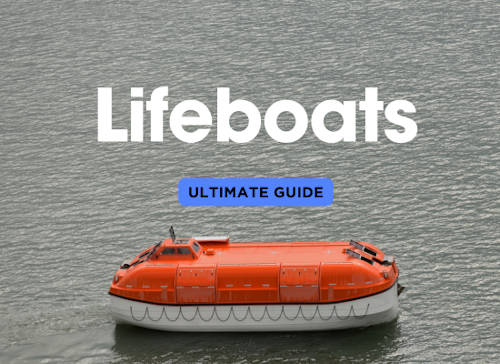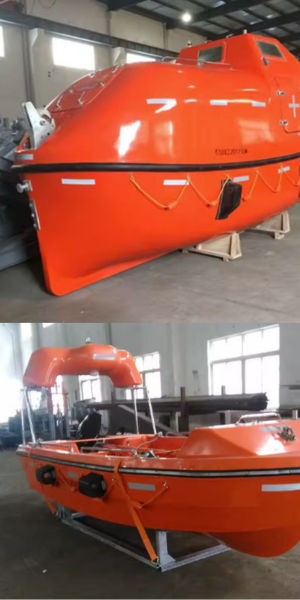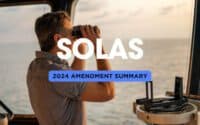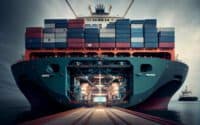Lifeboats on Board: Ultimate Guide

In the vast and unforgiving expanse of the world's oceans, lifeboats are the last line of defense for crew members when the unthinkable happens. For ship owners, ensuring that these critical pieces of safety equipment meet all necessary regulations is not just a legal obligation but a moral one as well. Lifeboat regulations are governed by a combination of international and national standards, designed to ensure that every ship at sea is equipped with reliable and effective lifesaving equipment. This guide will provide ship owners with a comprehensive overview of lifeboat requirements, helping them navigate the complex landscape of global maritime safety regulations. Whether you’re retrofitting an older vessel or outfitting a new build, understanding these regulations is crucial to maintaining compliance and, most importantly, safeguarding the lives of those on board.
Regulations / Lifeboats / Power / Cost / Maintenance / Emergency Training
Regulation Breakdown
Understanding global lifeboat regulations is essential for ship owners to ensure compliance and safety at sea. The table below provides a concise overview of the key regulations across various countries and regions, helping you navigate the complex requirements for lifeboats on commercial vessels.
| ShipUniverse: Global Lifeboat Regulations for Commercial Ships | |||
|---|---|---|---|
| Country/Region | Governing Body | Regulatory Framework | Key Lifeboat Requirements |
| International (SOLAS) | International Maritime Organization (IMO) | SOLAS Convention (Chapter III) |
- Minimum number of lifeboats based on ship size and type. - Lifeboats must be capable of being launched with full load within 5 minutes. - Lifeboats must have sufficient capacity for 100% of persons on board. - Regular maintenance and drills required. |
| United States | United States Coast Guard (USCG) | 46 CFR (Code of Federal Regulations) |
- Lifeboats must meet SOLAS requirements plus US-specific standards. - Additional requirements for fire-resistant materials. - Regular inspection and certification by USCG. - U.S. ships may require supplementary lifesaving equipment. |
| European Union | European Maritime Safety Agency (EMSA) | EU Maritime Safety Regulations (Directive 2009/45/EC) |
- Harmonized with SOLAS but may include additional safety measures. - Lifeboat capacity and design must be certified by recognized organizations. - Lifeboat engine and fuel systems must meet specific EU environmental standards. |
| China | China Classification Society (CCS) | CCS Rules for Statutory Surveys |
- Lifeboats must meet both SOLAS and CCS standards. - Special requirements for lifeboat capacity in heavy seas. - Regular inspections and certifications by CCS. - Mandatory emergency communication systems in lifeboats. |
| Japan | Japanese Maritime Safety Agency (JMSA) | Ship Safety Law of Japan |
- Lifeboats must adhere to SOLAS with additional Japanese regulations. - Enhanced standards for earthquake and tsunami resilience. - Mandatory regular drills and crew training. - Lifeboat materials must pass stringent quality tests. |
| Australia | Australian Maritime Safety Authority (AMSA) | Marine Order 25 (Equipment - Lifeboats and Rescue Boats) |
- Must comply with SOLAS and additional Australian standards. - Specific requirements for lifeboat buoyancy and stability. - Lifeboats must be equipped with additional survival equipment. - Regular inspections and drills mandated by AMSA. |
| South Korea | Korean Register of Shipping (KR) | Korean Ship Safety Act |
- Lifeboats must comply with SOLAS and KR-specific requirements. - Enhanced life-saving appliance standards for coastal and offshore operations. - Regular maintenance and certification by KR. - Emphasis on high-speed evacuation in emergencies. |
| Singapore | Maritime and Port Authority of Singapore (MPA) | Singapore Merchant Shipping Act |
- Compliance with SOLAS plus additional local safety requirements. - Lifeboats must undergo regular inspections and certification. - Special provisions for lifeboats on ships involved in offshore activities. - Lifeboat crew must be trained and certified under MPA guidelines. |
| India | Directorate General of Shipping (DGS) | Indian Merchant Shipping Act |
- Lifeboats must adhere to SOLAS and Indian-specific safety standards. - Regular drills and inspections are mandatory. - Lifeboats must have enhanced capacity and stability for tropical conditions. - DGS certification required for all life-saving appliances. |
| Brazil | Brazilian Navy (Marinha do Brasil) | NORMAM-01/DPC (Norms for Maritime Authority) |
- Lifeboats must meet SOLAS standards and Brazilian safety norms. - Special requirements for tropical and offshore operations. - Mandatory regular inspections by Brazilian Maritime Authority. - Lifeboats must include specific survival gear suited for tropical regions. |
| Canada | Transport Canada | Canada Shipping Act (CSA 2001) |
- Compliance with SOLAS and additional Canadian safety requirements. - Lifeboats must be designed for cold weather operations. - Regular inspection and certification by Transport Canada. - Enhanced survival equipment required for Arctic and Northern operations. |
Lifeboat Breakdown
Lifeboats are essential for maritime safety, with different types offering specific advantages depending on the ship's size, type, and operating conditions. The table below compares various lifeboats, highlighting their pros, cons, and typical applications, helping ship owners ensure compliance and safety at sea.
| ShipUniverse: Types of Lifeboats, Pros/Cons, and Applications | ||||
|---|---|---|---|---|
| Lifeboat Type | Pros | Cons | Common Applications | Required on Ship Types |
| Totally Enclosed Lifeboats |
- Full protection from weather and rough seas. - Fire-resistant and watertight. - Can be used in extreme conditions. |
- Heavier and bulkier than other lifeboats. - Higher maintenance due to complex systems. - Slower deployment compared to open or free-fall lifeboats. |
- Cargo ships - Passenger ships - Offshore platforms |
- Required on most modern cargo and passenger vessels. - Mandated by SOLAS for ships in harsh environments. |
| Partially Enclosed Lifeboats |
- Lighter and easier to deploy. - Provides some protection from the elements. - Simpler design, leading to lower maintenance. |
- Less protection compared to totally enclosed lifeboats. - Not suitable for extremely rough conditions. - Limited capacity and durability. |
- Coastal ships - Small passenger vessels - Ships in less severe operating environments |
- Often used where totally enclosed lifeboats are not required. - Suitable for smaller vessels and specific routes. |
| Free-Fall Lifeboats |
- Rapid deployment ensures quick evacuation. - Excellent for rough seas and emergencies. - Fully enclosed, providing maximum protection. |
- Requires specific launch equipment. - Can be challenging to maintain and inspect. - Limited to ships with suitable deck space. |
- Tankers - Offshore supply vessels - Ships requiring rapid evacuation |
- Mandated for tankers and ships needing fast deployment. - Often required on offshore platforms. |
| Rescue Boats |
- Highly maneuverable. - Can be launched quickly. - Essential for man-overboard situations. |
- Limited capacity (usually for small crews). - Less protection from the elements. - Not suitable for long-term survival. |
- All types of ships - Man-overboard rescues - Assisting with lifeboat deployment |
- Required on all ships as per SOLAS. - Essential for emergency and rescue operations. |
| Inflatable Lifeboats (Life Rafts) |
- Lightweight and easy to store. - Rapid deployment with automatic inflation. - Provides additional capacity in emergencies. |
- Vulnerable to punctures and weather conditions. - Limited shelter and comfort. - Requires regular inspection and maintenance. |
- Supplementary on all ship types - Short-term emergency situations - Additional survival capacity |
- Required as additional lifesaving equipment. - Often used on passenger ships and large vessels. |
| Open Lifeboats |
- Simple design, easy to operate. - Lightweight and requires minimal maintenance. - Can be manually operated (rowing). |
- No protection from the elements. - Limited capacity and safety features. - Becoming obsolete for most commercial ships. |
- Older vessels - Inland waters - Emergency use in calm conditions |
- Rarely required, mostly on older or smaller ships. - Not recommended for modern commercial vessels. |
| Davit-Launched Lifeboats |
- Controlled launch, even in rough conditions. - Can be used with both enclosed and partially enclosed lifeboats. - Suitable for ships with limited deck space. |
- Requires regular maintenance of davits and winches. - Slower than free-fall launch systems. - Complex deployment process. |
- Cargo ships - Passenger ships - Ships with standard lifeboat deployment systems |
- Common on many types of vessels. - Often used where free-fall systems are not feasible. |
Power Breakdown
Lifeboats are powered by specific types of engines designed for reliability and efficiency in emergencies. The table below outlines the common engines and fuel types used in lifeboats, highlighting their advantages and typical applications.
| ShipUniverse: Common Lifeboat Engines and Fuel Types | |||
|---|---|---|---|
| Engine Type | Fuel Type | Pros | Common Applications |
| Cummins (B-Series, QSB-Series) | Diesel |
- High durability and reliability. - Ease of maintenance. - Widely available parts and service. |
- Larger lifeboats on cargo and passenger ships. - Heavy-duty applications. |
| Volvo Penta (D4, D6 Series) | Diesel |
- Fuel-efficient and reliable. - Compact design with high power output. - Excellent reputation in marine applications. |
- Totally enclosed and partially enclosed lifeboats. - Offshore vessels and platforms. |
| Yanmar (4JH, 6LY Series) | Diesel |
- Compact and lightweight. - Proven reliability in various marine conditions. - High efficiency and low noise. |
- Smaller to mid-sized lifeboats. - Rescue boats on cargo and passenger ships. |
| Deutz (BF4M, BF6M Series) | Diesel |
- Robust construction with high power output. - Long service life. - Reliable in extreme conditions. |
- Lifeboats on heavy-duty ships. - Offshore platforms requiring robust engines. |
| Caterpillar (CAT C2.2, C4.4 Series) | Diesel |
- Powerful and reliable. - Designed for heavy-duty applications. - Excellent global support network. |
- Heavy-duty lifeboats and rescue boats. - Offshore vessels and larger ships. |
| Outboard Engines | Gasoline |
- Lightweight and easy to maintain. - Quick start and responsive throttle. - Ideal for smaller lifeboats. |
- Rescue boats and small, open lifeboats. - Typically used on smaller vessels. |
| Electric Motors | Battery/Electric |
- Quiet operation with no emissions. - Low maintenance requirements. - Immediate torque and simple controls. |
- Some modern rescue boats. - Lifeboats on environmentally sensitive vessels. |
Cost Breakdown
The cost of lifeboats and their installation on commercial ships can vary widely depending on the type of lifeboat, the ship’s size, and the specific installation requirements. Typically, the price of a lifeboat can range from $15,000 to $60,000 or more, depending on factors such as size, capacity, and the inclusion of advanced features like fireproofing, self-righting capabilities, or enclosed designs. Installation costs add to the total, requiring specialized equipment, davits or launching systems, and often shipyard labor. Installation costs can range from $5,000 to $20,000, depending on the complexity and modifications needed to accommodate the lifeboat.
Ship owners must also consider ongoing maintenance, inspection, and certification costs, which are crucial for ensuring that lifeboats are always in a state of readiness. These additional costs can range from a few hundred to several thousand dollars annually.
| ShipUniverse: Lifeboat Total Cost Breakdown | |||
|---|---|---|---|
| Cost Component | Typical Cost Range (USD) | Details | Considerations |
| Lifeboat Purchase | $15,000 - $60,000+ |
- Cost depends on size, type (enclosed, free-fall, open), and features. - Higher costs for lifeboats with advanced features like fireproofing, enclosed designs, or self-righting capabilities. |
- Consider the specific needs of the ship and the operating environment. - Choose a lifeboat that meets SOLAS and other regulatory requirements. |
| Installation | $5,000 - $20,000+ |
- Includes labor, installation of davits/launching systems, and any necessary ship modifications. - Costs can vary based on the complexity of the installation. |
- Requires specialized shipyard services. - Installation should be carried out by certified professionals to ensure compliance with safety standards. |
| Launching Equipment | $10,000 - $50,000+ |
- Cost for davits, winches, and other launching equipment. - Price varies depending on the type of lifeboat and required equipment. |
- Essential for the safe and effective deployment of lifeboats. - Regular maintenance of this equipment is critical. |
| Maintenance and Certification | $500 - $5,000+ per year |
- Regular inspections, servicing, and certification to ensure lifeboats remain in operational condition. - Costs depend on the frequency of inspections and complexity of maintenance. |
- Necessary for compliance with international regulations. - Helps ensure lifeboats are ready for emergency use at all times. |
| Spare Parts and Equipment | $1,000 - $10,000+ |
- Includes spare parts for engines, safety equipment, and other essential components. - Cost depends on the type of lifeboat and manufacturer. |
- Maintaining a stock of critical spare parts can minimize downtime during repairs. - Ensure that parts are readily available for the specific lifeboat model. |
| Training and Drills | $1,000 - $5,000+ per year |
- Cost for crew training, lifeboat drills, and safety exercises. - Ongoing training is essential to ensure crew competence in emergency situations. |
- Regular drills are required by SOLAS and other maritime regulations. - Training should cover all aspects of lifeboat deployment and operation. |

Factory Direct = Huge Savings
| Current Lifeboat Pricing | |||
|---|---|---|---|
| Type | Capacity | Cost | Shipping |
| Fully enclosed | 20P | $10k - $12k | $3.5k |
| * More sizes, bulk discounts, and customization available. | |||
* Secure Your Crew’s Safety with Top-Rated Lifeboats!
* High-end lifeboats trusted by top fleets.
Maintenance Breakdown
Proper maintenance of lifeboats is crucial to ensure they function reliably in emergencies. Regular inspections, adherence to maintenance schedules, and awareness of common issues can prevent failures and ensure that lifeboats are always ready for deployment. The table below outlines best practices for maintaining lifeboats, including recommended inspection schedules and key areas to monitor for optimal performance.
| ShipUniverse: Lifeboat Maintenance Best Practices | |||
|---|---|---|---|
| Maintenance Task | Recommended Frequency | Details | Common Issues to Watch For |
| Visual Inspection | Monthly |
- Inspect lifeboat exterior and interior for damage, corrosion, or wear. - Check for signs of UV damage or material degradation. |
- Cracks or fractures in the hull. - Corrosion on metal components. - Wear on seals and gaskets. |
| Engine Maintenance | Quarterly |
- Check oil levels, filters, and fuel lines. - Test engine starting and operation under load. - Inspect exhaust and cooling systems. |
- Fuel contamination or leakage. - Difficulty starting the engine. - Overheating or unusual noises. |
| Launch Equipment Inspection | Biannually |
- Inspect davits, winches, and cables for wear and proper operation. - Lubricate moving parts and check for proper tension. |
- Fraying or corrosion of cables. - Malfunctioning winches or davits. - Lack of lubrication leading to stiffness. |
| Safety Equipment Check | Monthly |
- Verify that all safety equipment (life jackets, flares, first aid kits) is present and in good condition. - Check expiration dates and replace as necessary. |
- Expired flares or first aid supplies. - Missing or damaged life jackets. - Malfunctioning communication equipment. |
| Hull Cleaning and Antifouling | Annually |
- Clean hull to remove marine growth and apply antifouling paint as needed. - Inspect for damage or blistering. |
- Excessive marine growth slowing deployment. - Blistering or peeling of antifouling paint. - Hull damage from impact or abrasion. |
| Full Functionality Test | Annually |
- Conduct a full deployment test, including lowering and raising the lifeboat, engine start, and navigation. - Record any issues and address them promptly. |
- Malfunction during deployment. - Engine failure or poor performance. - Difficulty in raising the lifeboat. |
| Regulatory Inspection | As per flag state requirements |
- Schedule inspections with the relevant maritime authority. - Ensure all maintenance records are up to date and available for review. |
- Non-compliance with safety regulations. - Outdated certification or documentation. - Unaddressed maintenance issues. |
Emergency Training Breakdown
In an emergency, the rapid and safe deployment of lifeboats is critical to saving lives. Proper procedures and crew preparedness are essential to ensure that lifeboats can be launched quickly and efficiently under challenging conditions. The table below outlines best practices for emergency deployment procedures, offering guidelines to help ship owners and crews execute effective evacuations.
| ShipUniverse: Lifeboat Emergency Deployment Procedures | |||
|---|---|---|---|
| Procedure | Step-by-Step Guidelines | Key Considerations | Common Challenges |
| Initial Alert |
- Sound the general alarm. - Notify the crew and passengers of the emergency situation. - Direct everyone to muster stations. |
- Ensure alarms are loud and clear. - Communicate the nature of the emergency clearly. - Maintain order and avoid panic. |
- Delays in alerting crew. - Miscommunication leading to confusion. - Panic among passengers. |
| Preparation for Launch |
- Check lifeboats for readiness (remove covers, secure loose items). - Ensure that all safety equipment is onboard. - Assign crew members to specific roles for launching. |
- Verify that all equipment is in place and functioning. - Ensure that the crew is aware of their assigned roles. - Clear the area around the lifeboats. |
- Equipment malfunctions or missing items. - Unclear role assignments. - Obstructions preventing clear access to lifeboats. |
| Muster and Boarding |
- Direct crew and passengers to muster stations. - Conduct a headcount to ensure everyone is accounted for. - Begin boarding the lifeboat in an orderly manner. |
- Ensure calm and orderly boarding. - Prioritize vulnerable individuals (children, elderly, injured). - Double-check headcounts before launch. |
- Difficulty in accounting for everyone. - Overcrowding or disorderly boarding. - Communication breakdowns during boarding. |
| Lifeboat Launch |
- Lower the lifeboat using davits or other launching systems. - Ensure the lifeboat is fully in the water before releasing hooks. - Start the engine and move away from the ship. |
- Coordinate with the entire crew for smooth operation. - Monitor for any issues with the launching mechanism. - Release hooks only when the lifeboat is stable in the water. |
- Malfunctioning davits or winches. - Premature release of hooks. - Rough seas or ship instability causing difficulties. |
| Post-Launch Procedures |
- Move the lifeboat a safe distance from the ship. - Begin using emergency communication equipment to signal for help. - Distribute life jackets and ensure all are secured. |
- Maintain communication with other lifeboats. - Avoid hazardous areas near the ship. - Check that all passengers are safe and accounted for. |
- Loss of communication with the ship or other lifeboats. - Difficulty in navigating away from the ship. - Inadequate distribution of life jackets. |
| Survival Operations |
- Administer first aid to those in need. - Conserve resources (food, water, energy). - Maintain morale and prepare for extended survival. |
- Keep everyone calm and focused. - Regularly check supplies and rations. - Rotate watch duties among the crew. |
- Running out of supplies before rescue. - Low morale among passengers. - Physical exhaustion and exposure to elements. |
Get the Best Deals Straight from the Builder!

| Current Lifeboat Pricing | |||
|---|---|---|---|
| Type | Capacity | Cost | Shipping |
| Fully enclosed | 20P | $10k - $12k | $3.5k |
| * More sizes, bulk discounts, and customization available | |||
* Secure Your Crew’s Safety with Top-Rated Lifeboats!
* High-end lifeboats trusted by top fleets.
Additional References
International Maritime Organization (IMO) - Safety of Life at Sea (SOLAS) Convention
- URL: https://www.imo.org/en/OurWork/Safety/Pages/Default.aspx
- Description: The IMO's official page on the Safety of Life at Sea (SOLAS) Convention, which sets international regulations for lifeboats and other life-saving appliances on ships.
United States Coast Guard (USCG) - Lifesaving Equipment
- URL: https://www.dco.uscg.mil/Our-Organization/Assistant-Commandant-for-Prevention-Policy-CG-5P/Inspections-Compliance-CG-5PC-/Commercial-Vessel-Compliance/Lifesaving-and-Fire-Safety-Division/Lifesaving-Equipment/
- Description: The USCG's official page providing guidelines and regulations for lifesaving equipment, including lifeboats, on commercial vessels in the United States.
European Maritime Safety Agency (EMSA) - Lifesaving Appliances
- URL: https://www.emsa.europa.eu/main/safety/112-lifesaving-appliances.html
- Description: EMSA’s resource page on lifesaving appliances, including lifeboat regulations and safety guidelines applicable within the European Union.
Australian Maritime Safety Authority (AMSA) - Marine Orders Part 25: Equipment - Lifeboats and Rescue Boats
- URL: https://www.amsa.gov.au/vessels-operators/regulations-and-standards/marine-orders/marine-order-25-equipment-lifeboats-and-rescue-boats
- Description: AMSA’s official page detailing the marine orders related to lifeboats and rescue boats, outlining the safety standards and regulations in Australia.
Transport Canada - Lifesaving Equipment
- URL: https://tc.canada.ca/en/marine-transportation/marine-safety/lifesaving-equipment
- Description: Transport Canada’s page on lifesaving equipment, including lifeboats, with guidelines for compliance with Canadian regulations on commercial vessels.

Do you have a Maritime Product or Service that may be of interest to Shipowners? Tell us about it here!
Do you have feedback or insights? Please reach out to editor @ shipuniverse.com



